Nixeus NX-VUE27 27" Monitor: High Resolution for the Masses
by Chris Heinonen on September 20, 2012 6:10 PM ESTDisplay Uniformity
With the primary measurements out of the way, we now turn to testing display uniformity. It's easier to get good results at the center of a display, while extending the results to the corners and edges requires a lot more effort. Let's see how uniform the Nixeus is.
When the center of the ANSI grid is set to 200 nits of brightness, the surrounding blocks are all close, though it is better at the lower section of the screen with an average of 95% of the center brightness. Once you move to the outside of the monitor the readings drop by at least 7%, falling all the way to a 17% drop off in one corner. The overall average is 89% of the center brightness, or 181 nits. This is actually pretty normal for monitors, particularly larger models, and it's only very expensive professional displays like the NEC display we reviewed that tend to do better.
Black uniformity does not mirror the white uniformity in this case, which could be due to the updated testing method, panel and backlighting uniformity, or a combination of both. The deepest blacks we get are in the corner with 0.353 nits in the upper-left, which also happens to be the darkest spot in the white uniformity testing. The brightest spot, no surprise, is in the center of the screen that measures 0.420 nits. The average black level winds up at 0.390 nits for all measurements. This is okay for black levels but certainly not outstanding.
Our contrast is more uniform across the panel, as areas with high white levels typically have high black levels as well, an indication of the backlight level in that section of the screen. The exception seems to be the upper-right section of the screen where we have higher black levels and lower white levels. I thought these were suspect and measured them multiple times, but always found the same results. The average contrast ratio for the center of the panel is 473:1 and for the outside it's 461:1, so that is fairly uniform for the whole display.
Looking at the dE uniformity of the Nixeus, it tracks really well across the whole screen. The main errors occur in the grayscale, which is what we typically see, but otherwise the numbers are almost spot on across the monitor. We do see a rise on the left side of the monitor relative to the rest of the display, likely from the lighting uniformity issues, but there aren't any extreme variances.
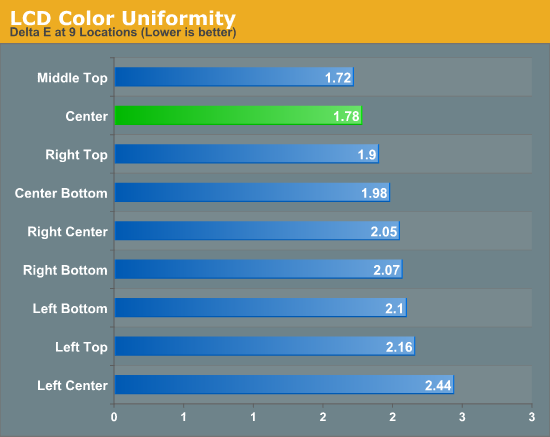
In summary, the uniformity of the Nixeus NX-VUE27 is decent and is similar to what we have seen from other non-professional 27” flat panels. The contrast ratio leaves a good bit to be desired, as the black floor is not what it should be in this display. I could enable the Dynamic Contrast mode to help that, but since it has only one setting and is very noticeable (not in a good way), I wasn’t inclined to enable it.


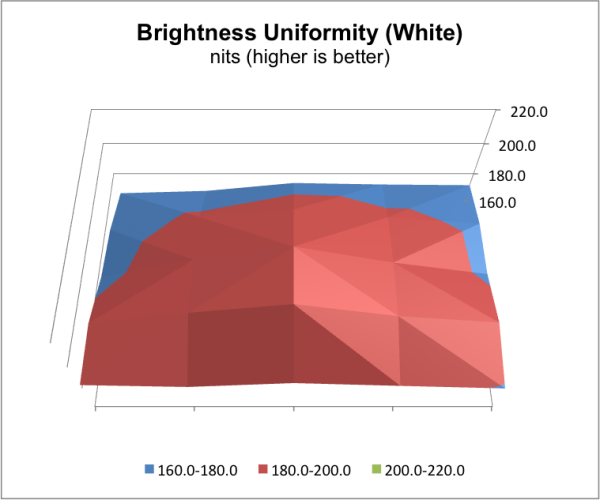
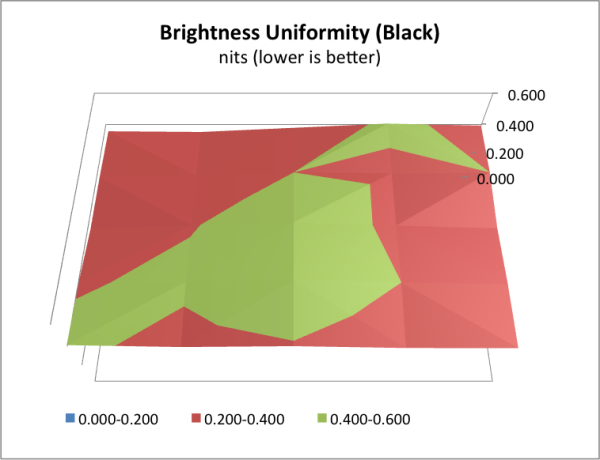
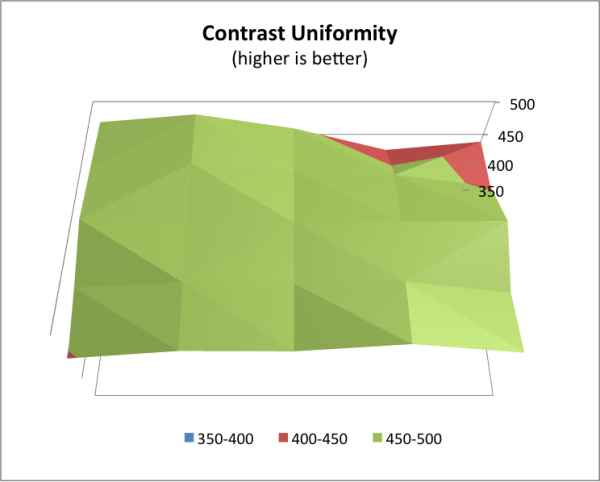
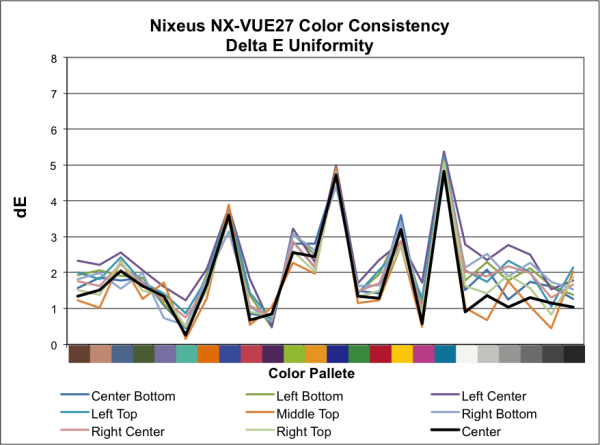
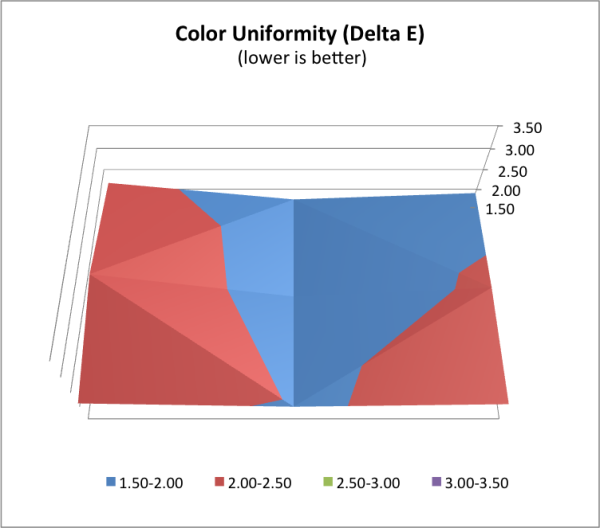








66 Comments
View All Comments
sheh - Thursday, September 20, 2012 - link
Too bad they kept the size and reduced the resolution rather than vice versa. :)Confusador - Friday, September 21, 2012 - link
Amen! I really want this resolution, but can't stand anything bigger than 23"falko2904 - Friday, September 21, 2012 - link
But that Dell is significantly lower resolution. It is only 1920x1080 (actually fine by me for what I would want). The class of monitors being talked about have 2560x1440 resolution.LIke I said, for my purpose, I actually like that Dell.
ikoss - Friday, September 21, 2012 - link
Dude.. that's 1080p crap, not to mention not likely to be an IPS!DanNeely - Sunday, September 23, 2012 - link
It's listed as IPS on the spec page; might only be eIPS though.Sabresiberian - Friday, September 21, 2012 - link
1920x1080 @ 27" might be fine for a TV across the living room, but it's crap for a monitor.RaistlinZ - Thursday, September 20, 2012 - link
Poor contrast, poor color gamut, high input lag, high power draw, mediocre build quality.You get what you pay for.
cheinonen - Friday, September 21, 2012 - link
I'm just going to suggest you didn't fully read the article or didn't look at similar displays in the results tables. The contrast was poor in comparison to the HP 27" display, but was close to the results from the NEC and DoubleSight panels. The color gamut is sRGB, exactly what it was specified for, and exactly what you get. The power draw was lower than all the other tested 27" displays, so that was good, and I commented plenty on the build quality.With input lag, other than the HP ZR2740w, which has no scaler, the input lag on all the other 27" models is almost identical (and the new review has the same issue). Whatever scaler is being used isn't incredibly fast, and combined with the response time of the display, the absolute minimum you are going to get is 1 frame. If you run at 1440p, you might get exactly 1 frame, but as I said, I have no way of knowing this. So in comparison to 27" displays, the lag, gamut, contrast, and power draw are either close to the same or better in most cases, with the build quality being the main issue in comparison.
sheh - Thursday, September 20, 2012 - link
...in case manufacturers scour the web for public opinion. :)Still waiting for hi-res in DPI rather than absolute number of pixels. And enough with 16:9. OLED aside, wanted: 3840x2400 in 24". If they don't start upping the DPI in desktop, soon enough cellphones will become higher-res (in pixels) than desktop monitors.
magreen - Thursday, September 20, 2012 - link
This.It's long past time for graphics drivers and operating systems to treat displays as a resolution independent output device, the way printers are. When you print a document to a printer that can print 600 dpi, it looks just like that same document printed on a 300 dpi printer except a bit sharper.
I'm so tired of having to blow up pdfs and word documents to much larger than their actual size because otherwise I can't read the smaller text (even if I put my face close to the monitor).